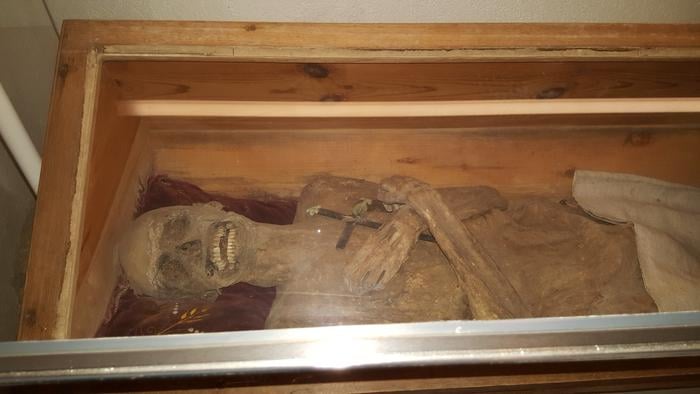A 300-year-old mystery has been solved through modern science, revealing a preservation method never before documented in the historical record. Researchers have discovered that an exceptionally well-preserved Austrian mummy known as the “air-dried chaplain” was embalmed through an unusual technique that involved packing materials inserted through the rectum.
The mummy, housed in the church crypt of St. Thomas am Blasenstein in Upper Austria, has long fascinated visitors and scientists alike with its remarkably intact condition. Now, an international research team led by Dr. Andreas Nerlich has definitively identified the body and uncovered its preservation secrets.
“The unusually well-preserved mummy in the church crypt of St Thomas am Blasenstein is the corps of a local parish vicar, Franz Xaver Sidler von Rosenegg, who died in 1746,” said Dr. Nerlich, a pathologist at Ludwig-Maximilians-Universität and first author of the study published in Frontiers in Medicine.
Through detailed CT scans, focal autopsy, and radiocarbon dating, researchers discovered the mummy’s abdominal cavity had been packed with wood chips, twigs, fabric fragments, and even pieces of silk. Most surprisingly, this material was inserted through the rectum rather than through an incision in the abdominal wall as seen in better-known embalming traditions.
“Our investigation uncovered that the excellent preservation status came from an unusual type of embalming, achieved by stuffing the abdomen through the rectal canal with wood chips, twigs and fabric, and the addition of zinc chloride for internal drying,” Nerlich explained.
The materials would have rapidly absorbed decaying matter and bodily fluids. Toxicological analysis also revealed high levels of zinc, likely from zinc chloride, which has strong drying and antimicrobial properties – creating a perfect preservation environment from within.
Beyond solving the preservation mystery, the research provided a window into Sidler’s life. Isotope analysis showed he enjoyed a high-quality diet consistent with his status as a parish vicar. Evidence suggested he was a pipe smoker who suffered from pulmonary tuberculosis, which likely caused his death at approximately 37 years of age through acute pulmonary hemorrhage.
The researchers believe this embalming method may have been more common than previously thought. “This type of preservation may have been much more widespread but unrecognized in cases where ongoing postmortal decay processes may have damaged the body wall so that the manipulations would not have been realized as they were,” noted Nerlich.
This discovery overturns previous assumptions that the mummy was naturally preserved by crypt conditions, offering rare insight into historical embalming practices that have remained hidden for centuries.
If our reporting has informed or inspired you, please consider making a donation. Every contribution, no matter the size, empowers us to continue delivering accurate, engaging, and trustworthy science and medical news. Independent journalism requires time, effort, and resources—your support ensures we can keep uncovering the stories that matter most to you.
Join us in making knowledge accessible and impactful. Thank you for standing with us!

